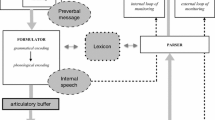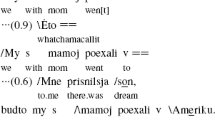Abstract
Self-repairs, that is revisions of speech that speakers themselves initiate and complete (Salonen and Laakso in J Child Lang 36:859, 2009. https://doi.org/10.1017/s0305000908009240), are frequently used to observe the cognitive and linguistic processes underlying second language (L2) speech production. Previous research has shown that factors such as L2 proficiency, attentional control and native language (L1) self-repair behavior interact with L2 self-repair behavior. To our knowledge, however, no research has examined how these three factors interact within a cohort of L2 speakers. As such, the present study examined the proficiency scores, attentional control scores and L2 and L1 self-repair frequency data of 58 adult L2 English speakers of various proficiency levels. Regression results showed that while proficiency was not a significant predictor of L2 self-repair behavior, attentional control and L1 repair frequency together explained 40% of the variance. Results suggest that L2 self-repair behavior may be more closely linked to stable cognitive and personality traits than to L2 proficiency.
Similar content being viewed by others
Notes
In Levelt’s 1989 model, lexical access was depicted as occurring in the formulator, however, in a more recent version of the model (Levelt 1999, pp. 87–88), lexical access is depicted as starting in the conceptual phase of production. Levelt argues that the conceptual structure of the preverbal message depends of the structure of the lexical concepts of which it is composed.
Note that Determiner repairs were coded as conceptual repairs only when they entailed a semantic change to its definiteness, such as a change from the indefinite to the definite article. Determiner repairs targeting gender and number agreement were coded as morphological formulator errors.
Note that the Trail Making Test offers negative results, that is, higher scores indicate lower attention control.
To verify the extent of the predictive power between attentional control and L1 and L2 self-repairs, a stepwise regression analysis was conducted with L2 self-repairs as the dependent variable and attentional control, L1-self-repairs and a new variable combining attentional control and L1 self-repairs as independent variables. The resulting Model explains 41% of the variance [R2 = .41, F(3,50) = 36,13, p < .001]. However, only the combined variable [β = .640, t(1) = − 6.01, p = .000] was a significant predictor of L2 self-repairs, that is, both attentional control and L1 repair-behavior were excluded from the analyses when the combined variable was added to the model.
References
Arbuthnott, K., & Frank, J. (2000). Executive control in set switching: Residual switch cost and task-set inhibition. Canadian Journal of Experimental Psychology, 54, 33–41. https://doi.org/10.1037/h0087328.
Arroyo, E. (2003). La reformulation en communication exolingue chez des locuteurs hispanophones parlant français. Marges linguistiques, septembre octobre. http://www.marges-linguistiques.com. Visited in May 2009.
Bange, P., & Kern, S. (1996). La régulation du discours en L1 et en L2. Études Romanes, 35, 69–103.
Brédart, S. (1991). Word interruption in self-repairing. Journal of Psycholinguistic Research, 20, 123–137. https://doi.org/10.1007/bf01067879.
Camps, J. (2003). The analysis of oral self-correction as a window into the development of past time reference in Spanish. Foreign Language Annals, 36, 233–242.
Crookes, G. (1989). Planning and interlanguage variation. Studies in Second Language Acquisition, 11, 367–383. https://doi.org/10.1017/s0272263100008391.
de Bot, K. (1992). A bilingual production model: Levelt’s “speaking” model adapted. Applied Linguistics, 13, 1–24. https://doi.org/10.1093/applin/13.1.1.
Derwing, T. M., Munro, M. M., Thomson, R. I., & Rossiter, M. J. (2009). The relationship between L1 fluency and L2 fluency development. Studies in Second Language Acquisition, 31, 533–557. https://doi.org/10.1017/s0272263109990015.
Dietrich, R. (1982). Self-corrections. Case studies in the speech of adult learners of German as a foreign language. Zeitschrift für Literaturwissenschaft und Linguistik, 12, 120–151.
Ellis, R. (1987). Interlanguage variability in narrative discourse: Style shifting in the use of the past tense. Studies in Second Language Acquisition, 9, 12–20. https://doi.org/10.1017/s0272263100006483.
Fincher, A. (2006). Functions of self-initiated self-repairs in an advanced Japanese language classroom. Unpublished dissertation, Griffith University, Australia.
Foster, P., & Skehan, P. (1996). The influence of planning and task type on second language performance. Studies in Second Language Acquisition, 18, 299–323. https://doi.org/10.1017/s0272263100015047.
Gilabert, R. (2007). Effects of manipulating task complexity on self-repairs during L2 oral production. International Review of Applied Linguistics, 45, 215–240. https://doi.org/10.1515/iral.2007.010.
Golonka, E. (2006). Predictors revised: Linguistic knowledge and metalinguistic awareness in second language gain in Russian. Modern Language Journal, 90, 496–505. https://doi.org/10.1111/j.1540-4781.2006.00428.x.
Griggs, P. (1997). Metalinguistic work and the development of language use in communicative pair-work activities involving second language learners. In L. Diaz & C. Pérez (Eds.), Views on the acquisition and the use of second languages (pp. 403–415). Barcelona: Universitat Pompei Fabrat.
Kane, M. J., Conway, A. R. A., Hambrick, D. Z., & Engle, R. W. (2007). Variation in working memory capacity as variation in executive attention and control. In A. R. A. Conway, C. Jarrold, M. J. Kane, A. Miyake (Eds.), Variation in working memory (pp. 21–48). Oxford: Oxford University Press.
Kormos, J. (1998). A new psycholinguistic taxonomy of self-repairs in L2: A qualitative analysis with retrospection. The Even Yearbook, 3, 43–68.
Kormos, J. (1999). The effect of speaker variables on the self-correction behavior of L2 learners. System, 27, 207–221. https://doi.org/10.1016/s0346-251x(99)00017-2.
Kormos, J. (2000a). The role of attention in monitoring second language speech production. Language Learning, 50, 343–384. https://doi.org/10.1111/0023-8333.00120.
Kormos, J. (2000b). The timing of self-repairs in second language speech production. Studies in Second Language Acquisition, 22, 145–167.
Kormos, J. (2006). Speech production and second language acquisition. Mahwah, NJ: Lawrence Erlbaum Associates.
Lafrance, A., & Gottardo, A. (2005). A longitudinal study of phonological processing skills and reading in bilingual children. Applied Psycholinguistics, 26, 559–578. https://doi.org/10.1017/s0142716405050307.
Larson-Hall, J. (2010). A guide to doing statistics in second language research using SPSS. New York: Routledge.
Lennon, P. (1990). Investigating fluency in EFL: A quantitative approach. Language Learning, 40, 387–417. https://doi.org/10.1111/j.1467-1770.1990.tb00669.x.
Levelt, W. J. M. (1983). Monitoring and self-repair in speech. Cognition, 33, 41–103. https://doi.org/10.1016/0010-0277(83)90026-4.
Levelt, W. (1989). Speaking: From intention to articulation. Cambridge, MA: MIT Press.
Levelt, W. (1999). Producing spoken language: A blueprint of the speaker. In C. Brown & P. Hagoort (Eds.), The neurocognition of language (pp. 83–122). Oxford, UK: Oxford University Press.
Mayer, M. (1967). A boy, a dog and a frog. New York: Penguin Putnam.
Mayer, M. (1969). Frog where are you?. New York: Penguin Putnam.
Möhle, D. (1984). A comparison of the second language speech production of different native speakers. In H. W. Dechert, D. Möhle, & M. Raupach (Eds.), Second language productions (pp. 26–49). Tübingen, Germany: Gunter Narr Verlag.
O’Connor, N. (1988). Repairs as indicative of interlanguage variation and change. In T. J. Walsh (Ed.), Georgetown University round table in languages and linguistics 1988: Synchronic and diachronic approaches to linguistic variation and change (pp. 251–259). Washington, DC: Georgetown University Press.
O’Donnell, J., MacGregor, L., Dabrowski, J., Oestreicher, J., & Romero, J. (1994). Construct validity of neuropsychological tests of conceptual and attentional abilities. Journal of Clinical Psychology, 50, 596–600. https://doi.org/10.1002/1097-4679(199407)50:4<596::aid-jclp2270500416>3.0.co;2-s.
O’Brien, I., Segalowitz, N., Freed, B., & Collentine, J. (2007). Phonological memory predicts second language oral fluency gains in adults. Studies in Second Language Acquisition, 29, 557–581. https://doi.org/10.1017/s027226310707043x.
Ortega, L. (1999). Planning and focus on form in L2 oral performance. Studies in Second Language Acquisition, 21, 109–148.
Partington, J. E., & Leiter, R. G. (1949). Partington’s pathway test. The Psychological Service Center Bulletin, 1, 9–20.
Reitan, R. (1955). The relation of the Trail Making Test to organic brain damage. Journal of Consulting Psychology, 19, 393–394.
Reitan, R. (1958). Validity of the Trail Making Test as an indicator of organic brain damage. Perceptual and Motor Skills, 8, 271–276.
Rossiter, J. M., Derwing, T. M., & Jones, V. L. M. O. (2008). Is a picture worth a thousand words? TESOL Quarterly, 42, 325–329. https://doi.org/10.1002/j.1545-7249.2008.tb00127.x.
Royer, C. (2002). L’appropriation de la négation du français eu milieu guidé: une approche interactionniste. Marges Linguistiques, novembre. http://www.marges-linguistiques.com. Visited in May 2009.
Salonen, T., & Laakso, M. (2009). Self-repair of speech by four-year-old Finish children. Journal of Child Language, 36, 855–882. https://doi.org/10.1017/s0305000908009240.
Schmidt, R. (1990). The role of consciousness in second language learning. Applied Linguistics, 11, 129–158.
Schmidt, R. (2001). Attention. In P. Robinson (Ed.), Cognition and second language instruction (pp. 3–32). Cambridge, UK: Cambridge University Press.
Segalowitz, N. (2010). Cognitive bases of second language fluency. New York: Routledge.
Simard, D., Bergeron, A., Liu, Y.-G., Nader, M., & Redmond, L. (2016). Production d’autoreformulations autoamorcées en langue seconde : rôle de l’attention et de la mémoire phonologique. Revue canadienne des langues vivantes, 72, 183–210. https://doi.org/10.3138/cmlr.2767.
Simard, D., Fortier, V., & Zuniga, M. (2011). Attention et production d’autoreformulations autoamorcées en français langue seconde, quelle relation? Journal of French Language Studies, 21(3), 417–436. https://doi.org/10.1017/s0959269510000591.
Tognoli, E., & Toniolo, A. M. (2003). L’attention chez l’enfant: mesures capacitaires ou mesures processuelles. Psychologie et psychométrie, 24, 11–40.
Tombaugh, T. (2004). Trail making test A and B: Normative data stratified by age and education. Archives of Clinical Neuropsychology, 19, 203–214. https://doi.org/10.1016/s0887-6177(03)00039-8.
Tomlin, R., & Villa, H. (1994). Attention in cognitive science and second language acquisition. Studies in Second Language Acquisition, 16, 183–203.
van Hest, E. (1996). Self-repair in L1 and L2 production. Tilburg: Tilburg University Press.
Wiese, R. (1984). Language production in foreign and native languages: same or different. In H. W. Dechert, D. Möhle, & M. Raupach (Eds.), Second language productions (pp. 11–25). Tübingen, Germany: Gunter Narr Verlag.
Yochim, B., Baldo, J., Nelson, A., & Delis, D. (2007). D-KEFS Trail Making Test performance in patients with prefrontal cortex lesions. Journal of the International Neuropsychology Society, 13, 704–709. https://doi.org/10.1017/s1355617707070907.
Yuan, F., & Ellis, R. (2003). The effects of pre-task planning and on-line planning on fluency, complexity and accuracy in L2 monologic oral production. Applied Linguistics, 24, 1–27. https://doi.org/10.1093/applin/24.1.1.
Author information
Authors and Affiliations
Corresponding author
Ethics declarations
Conflict of interest
The authors declare that they have no conflict of interest.
Rights and permissions
About this article
Cite this article
Zuniga, M., Simard, D. Factors Influencing L2 Self-repair Behavior: The Role of L2 Proficiency, Attentional Control and L1 Self-repair Behavior. J Psycholinguist Res 48, 43–59 (2019). https://doi.org/10.1007/s10936-018-9587-2
Published:
Issue Date:
DOI: https://doi.org/10.1007/s10936-018-9587-2




